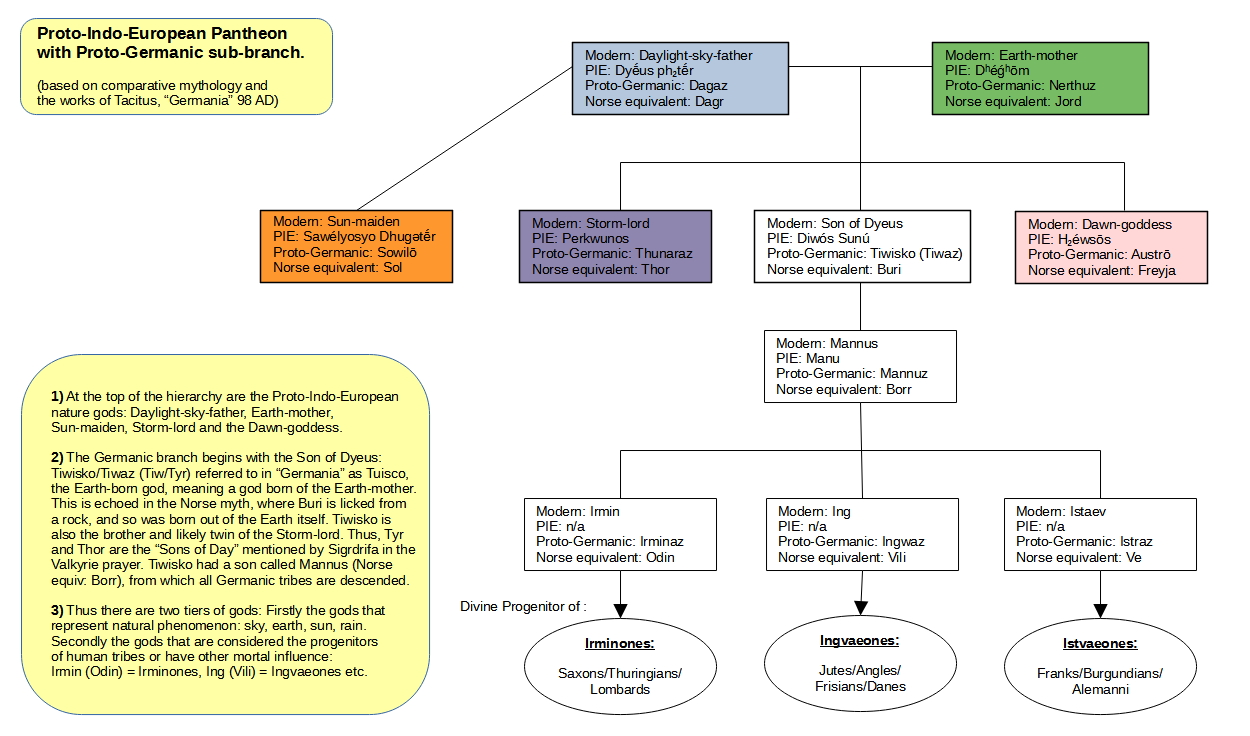Proto-Indo-European Pantheon with Proto-Germanic sub-branch
(based on comparative mythology and the works of Tacitus, “Germania” 98 AD)
I have reconstructed what I believe the Proto-Germanic Pantheon may have looked like during the time of Tacitus when he wrote “Germania” in 98 AD. This genealogy is based on the information given to us by Tacitus, specifically the following: “In their ancient songs, they celebrate Tuisco, a god brought forth from the Earth itself. They attribute to him a son, Mannus, the founder of their race and to Mannus three sons, from whose names the coastal tribes are called Ingvaeones; those in the interior, Irminones; and the rest, Istvaeones”.
This is interesting because we see significant cross-over between the older Proto-Indo-European (PIE) gods and a new sub-branch of Germanic gods branching off from the older religion. This begins with Tiwisko (Tuisco) whose name means Son of Dyēus and described in the above quote as the Earth-born god. This can only mean one thing: Tiwisko is the son of the PIE Daylight-sky-father and the Earth-mother. The god Tiwisko is therefore the glue that connects the older Proto-Indo-European religion and what was later to become Germanic heathenry and its offshoots (Saxon/Nordic), because he is the both the Son of Dyēus and the grandfather of Irmin/Woden/Odin.
Below is my interpretation of how this may have looked during this early era of Germanic heathenry. I’ve also added some additional explanatory notes in the yellow box. Click to zoom:
It's important to note that when I'm saying "Norse equivalent", I'm not saying that for example, Dagr is the Norse Sky-father. I'm meaning that "Dyēus" evolved over time into the persona of "Dagr" within the Norse pantheon. This occurred as the nature gods took a back seat, when a farming and pastoral lifestyle was replaced with the warlike culture of the migration era. Thus the Daylight-sky god (Dyēus=Dagr) was reduced to a minor role within the Norse pantheon. This occurred because the requirement for gods of war replaced the requirement for gods of farming (nature gods). Thus Dyēus, Dʰéǵʰōm, Sowilō took a backseat, however Perkwunos remained in a role of prominence, being seen as both a god of the rains and also a protector therefore somewhat warlike. Thus the shift from a farming culture to a war culture, facilitated the rise of Irmin/Woden/Odin as a god of war and death, and he took prominence within the later iterations of Germanic religions (Saxon/Nordic).
Also to note, traditionally Odin is considered to be the Sky-father of the Norse pantheon, but it depends on how you perceive this role. Does it simply mean, the chieftain of the gods? If so, then yes Odin assumes this role based on the Norse sources. However, Dyēus ph₂tēr really means "Daylight Father" or indeed the "Father of Daylight" or perhaps "Father of the Daylight Sky". This makes more sense when we conclude that Dyēus fathered the Sun-maiden and thus created day, when considering that it is the sun that causes daylight, thus Dyēus ph₂tēr, the father of daylight.
Odin, does not have solar, sky or daylight attributes himself. Other than perhaps one thing: it is said that he placed a spark from Muspelheim into the heavens and this is the sun. I would speculate that this is a function that the god Odin, which evolved from Irmin, assumed as he was elevated to the primary position within the Germanic pantheon. Thus he adopted an attribute of the former Sky-father. Odin's original primary attributes have little else in common with PIE Daylight-sky-father. Odin is the psychopomp (an entity that accompanies souls to the afterlife), a teacher of knowledge and magic, and a war god that would be prayed to for victory. Thus he is associated with the Roman Mercury (Wednesday=Mercredi afterall) and the Greek Hermes. I also can't help but notice the linguistic similarity between Irmin, which is sometimes spelt Hermin by Tacitus, and Hermes. But Irmin and his roots will be the topic of another post at a later time.




